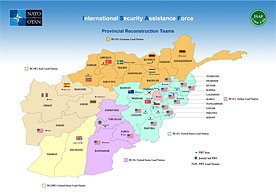Addressing the Afghanistan’s challenges requires a comprehensive approach, involving civilian and military actors, aimed not only at providing security but also at promoting good governance, the rule of law and long-term development. The Alliance acts in a supporting role to the Afghan government and works in close coordination with other international partners, including the United Nations Assistance Mission to Afghanistan, the World Bank, the European Union and the development community.
The Alliance also works closely with many non-member countries to help secure Afghanistan’s future. Currently, ISAF troop contributors include 22 partners from as far afield as Australia and Latin America. Altogether, they represent almost a quarter of all the member countries of the United Nations, underlining the broad international support for ISAF’s mission. For many years, Australia has been the top non-NATO troop-contributing nation. Georgia – currently the second largest partner troop contributor – is likely to become the largest, following planned deployments in autumn 2012.
Beyond troop contributors, many partners are supporting ISAF’s mission and the international community’s objectives in Afghanistan in other ways, such as through overflight and transit rights, or through financial support for building the capacity of the Afghan National Security Forces and for development projects. Examples of this important support are given below.
Cooperation with countries in the region
Countries in the region, particularly Pakistan, have important roles in ensuring enduring peace, stability and security in Afghanistan. They share a common interest in reducing the threat of extremism, promoting regional security, and addressing the problem of drug trafficking. NATO shares the same interests and concerns. One of the main NATO supply routes into and out of Afghanistan passes south through Pakistan. And NATO’s Central Asian partners – Kazakhstan, Kyrgyzstan, Tajikistan, Turkmenistan and Uzbekistan – have all provided some form of support to ISAF, including over-flight rights and the leasing of military bases to individual Allies. Kazakhstan and Uzbekistan (along with Russia, Belarus, and Ukraine) have provided rail networks through which non-lethal supplies can be transported to and from Afghanistan along a northern route.
NATO-Russia cooperation
NATO and Russia have a common interest in stabilizing Afghanistan and the broader region. Several initiatives are underway to help stabilize the country. One NRC project is assisting the Afghan Armed Forces to operate and maintain their helicopter fleet, as transition to Afghan security lead takes hold. Training of Afghan army helicopter maintenance staff on Russian territory began in April 2012. Under another successful NRC project, some 2000 Afghan, Central Asian and Pakistani counter-narcotics personnel have been trained to date, helping to develop regional capacity against the threat of drug trafficking.
Since 2008, Russia has facilitated the transit of non-military equipment for ISAF contributors across Russian territory in support of the ISAF mission. NATO-Russia transit arrangements proved critical to the development of the northern supply route to Afghanistan, linking rail transportation between Russia, Ukraine, Uzbekistan and Kazakhstan. Initially set for non-lethal equipment originating from NATO member states, the arrangement was extended to the non-NATO troop contributing nations, including reverse transit, at the NATO Lisbon Summit in November 2010. The current arrangement allows cargoes to travel by rail both to and from Afghanistan. At the Chicago Summit in May 2012, Allied leaders welcomed the progress on developing arrangements with Central Asian partners and Russia, which will allow multi-modal reverse transit, using a mix of rail and air transit for ISAF equipment through Russian territory.
Cooperation with Japan
While not a troop contributor, Japan is involved in a range of projects that enhance ISAF’s capabilities. By May 2011, Japan had given $2.49 billion worth of assistance to Afghanistan, in addition to providing more than 100 Japanese aid workers. In particular, Japan has provided financial support to human security projects in numerous regions of Afghanistan since 2007, in coordination with ISAF. Japan maintains a direct presence in the office of the NATO Senior Civilian Representative in Afghanistan to help coordinate the $20 million worth of funding through Japan’s Grassroots Grant Assistance Projects. Additionally, Japan has made generous contributions to a Partnership Trust Fund project in Afghanistan with a view to enhancing stockpile management and physical security of ammunitions and has also made valuable contributions to the ANA Trust Fund aimed at equipping and sustaining the Afghan National Army, including $20 million for literacy programmes in February 2012, in addition to procuring medical supplies.


